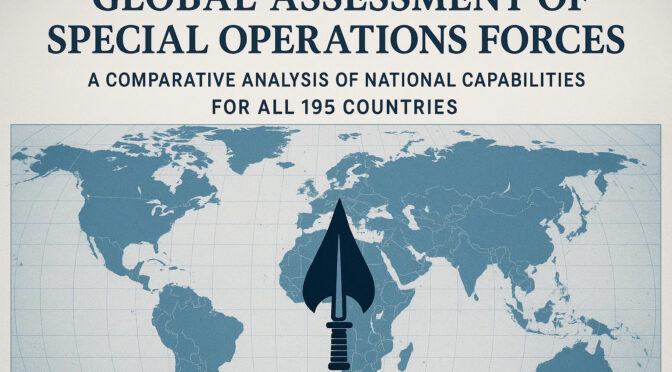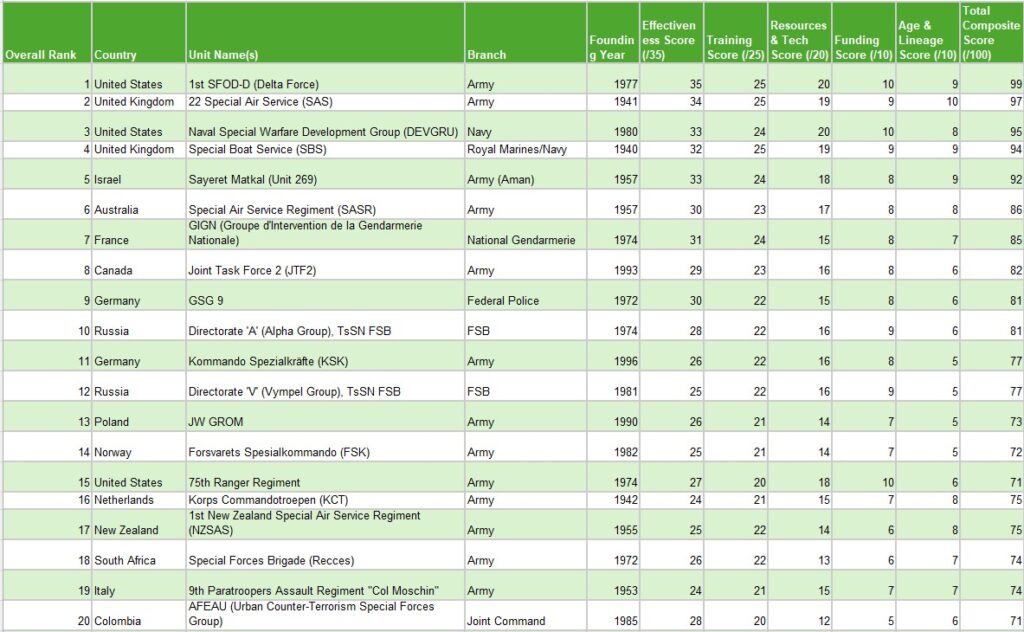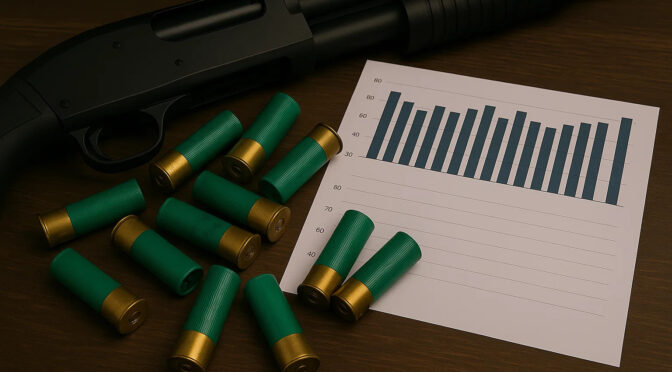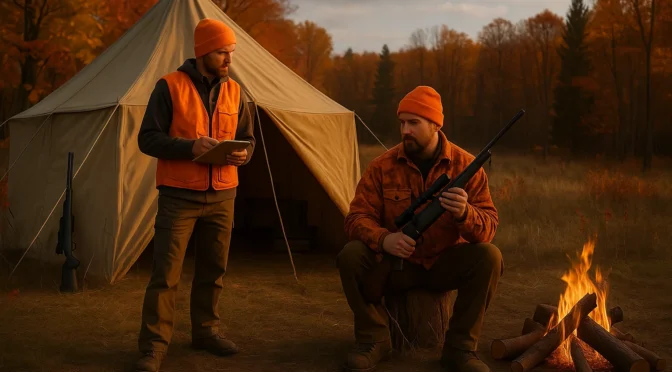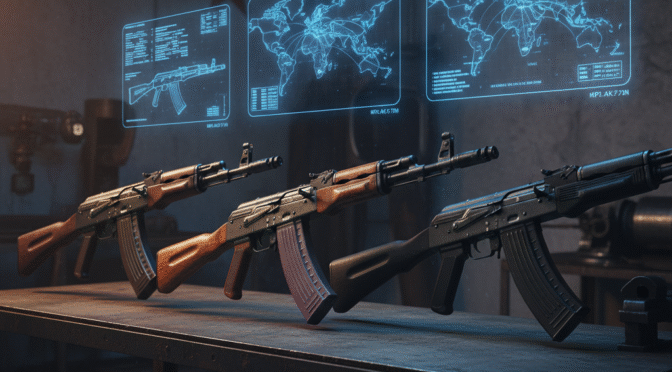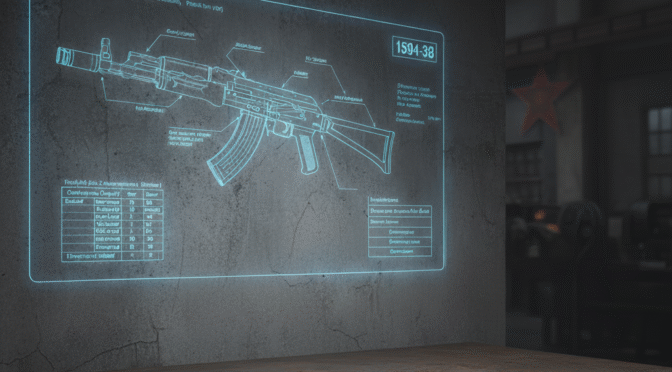This report presents the first comprehensive, open-source intelligence (OSINT) based assessment and ranking of the world’s military and governmental special operations forces (SOF). Utilizing a proprietary multi-attribute scoring model, we evaluate the SOF capabilities of 195 nations across five core pillars: Effectiveness, Training, Resources & Technology, Funding, and Age & Lineage. Our findings reveal a distinct stratification of global SOF, with a small cadre of “Tier 1” units possessing global reach, extensive combat experience, and integrated support structures that place them in a class of their own. Key trends identified include the global proliferation of SOF units post-9/11, a strategic pivot from counter-terrorism (CT) towards capabilities relevant to great power competition, and a persistent, significant capability gap between the top-tier units and the vast majority of national forces. The United States’ Joint Special Operations Command (JSOC) components, particularly the 1st SFOD-D (Delta Force) and the Naval Special Warfare Development Group (DEVGRU), alongside the United Kingdom’s 22 Special Air Service (SAS), emerge as the world’s preeminent special mission units. This status is derived not just from operator skill but from the vast, dedicated ecosystem of intelligence, aviation, and logistical support they command. This analysis serves as a strategic benchmark for understanding the current state and future trajectory of special warfare in an increasingly complex global security environment.
Section 1: The Contemporary Special Operations Landscape
1.1 Defining the Modern Special Operations Unit
To conduct a meaningful global comparison, a clear and rigorous definition of a Special Operations Force is paramount. This report adheres to the framework established by major military alliances like the North Atlantic Treaty Organization (NATO), which defines special operations as “military activities conducted by specially designated, organized, selected, trained and equipped forces using unconventional techniques and modes of employment”.1 These are not merely elite infantry or police units; they are strategic assets designed to achieve objectives that conventional forces cannot, often with a higher degree of political sensitivity and risk.2
The inclusion of a unit in this assessment is contingent on its primary mission set aligning with the core tenets of special warfare. These principal missions serve as a functional checklist for identifying a true SOF unit:
- Special Reconnaissance (SR): Operating deep within hostile, denied, or politically sensitive territory to gather intelligence of strategic or operational significance. This goes beyond tactical scouting and can include environmental reconnaissance, target analysis, and post-strike assessment.3
- Direct Action (DA): Short-duration strikes and other small-scale offensive actions to seize, destroy, capture, or recover targets. This is the “kinetic” aspect of SOF, encompassing raids, ambushes, and sabotage.1
- Counter-Terrorism (CT): The offensive measures taken to prevent, deter, and respond to terrorist acts. This is a highly specialized subset of DA, often involving hostage rescue and the targeting of specific terrorist cells or leaders.1
- Unconventional Warfare (UW): Operations conducted by, with, or through irregular forces, such as guerrilla or resistance movements. This is a hallmark of units like the U.S. Army Special Forces, requiring deep cultural and linguistic expertise.1
- Foreign Internal Defense (FID): The training, advising, and assisting of host-nation military and paramilitary forces to help them provide for their own national security.3
A critical distinction is made between military SOF and other elite formations. For instance, units like the U.S. Marine Corps Force Reconnaissance companies are highly trained but are primarily an asset for the conventional Marine Expeditionary Unit, lacking the strategic, national-level tasking of a designated SOF unit. Similarly, most police tactical units (e.g., Special Weapons and Tactics (SWAT) teams) are excluded, as their jurisdiction and mission are confined to domestic law enforcement. The exception is for paramilitary gendarmerie forces with a national-level strategic mandate, such as France’s Groupe d’Intervention de la Gendarmerie Nationale (GIGN) or Germany’s Grenzschutzgruppe 9 (GSG 9), which were created specifically to handle national-level terrorist crises and often operate overseas.6 This rigorous scoping ensures the analysis remains focused on true special operations forces.
1.2 The Evolution of Special Warfare: From WWII Raids to Hybrid Competition
The modern SOF operator is the product of over 80 years of operational evolution, forged in the crucible of global conflict. The lineage of today’s premier units can be traced directly to the specialized formations of World War II. In 1940, British Prime Minister Winston Churchill called for “specially trained troops of the hunter class” to “develop a reign of terror down the enemy coast,” leading to the formation of the Commandos.1 A year later, Lieutenant David Stirling founded the Special Air Service (SAS) in North Africa, pioneering the concept of small, autonomous teams operating deep behind enemy lines to conduct sabotage and reconnaissance.8 These units, along with clandestine organizations like the Special Operations Executive (SOE), established the foundational doctrines of special warfare.8
The post-war and Cold War periods saw this doctrine bifurcate. The SAS was re-formed and honed its skills in counter-insurgency and jungle warfare during the Malayan Emergency, while the United States established its own Army Special Forces (the “Green Berets”) with a primary focus on unconventional warfare—organizing and training resistance movements in case of a Soviet invasion of Europe.1
A new, more public chapter in SOF history began in the 1970s with the rise of international terrorism. The botched response to the 1972 Munich Olympics massacre, where German police were ill-equipped to handle a hostage crisis, was a watershed moment. It directly spurred the creation of dedicated, national-level counter-terrorism units like Germany’s GSG 9 and France’s GIGN.6 In the United States, the embarrassing failure of Operation Eagle Claw, the 1980 attempt to rescue American hostages in Iran, exposed critical gaps in U.S. capabilities. This led to a sweeping reorganization and the creation of a dedicated joint command (JSOC), a specialized aviation unit (the 160th Special Operations Aviation Regiment (Airborne) (160th SOAR)), and a maritime CT force (SEAL Team Six, now DEVGRU), complementing the Army’s Delta Force, which had been established in 1977 based on the SAS model.12
The attacks of September 11, 2001, ushered in what many consider the “Golden Age” of SOF. The subsequent Global War on Terror placed SOF at the forefront of national strategy, primarily focused on counter-terrorism and counter-insurgency campaigns in Afghanistan, Iraq, and beyond. This era saw an unprecedented expansion in SOF funding, resources, and operational tempo, with units honing their direct action and intelligence-driven targeting skills to a razor’s edge.15
However, the contemporary strategic landscape is shifting once again. The renewed focus on great power competition with peer and near-peer adversaries like China and Russia is driving a demand for a broader range of SOF capabilities. The most effective and forward-looking units today are those that are adapting to this new environment. They are reinvesting in the “classic” SOF skills of long-range reconnaissance, unconventional warfare, and foreign internal defense, while also integrating new domains like cyber and information operations.2 This demonstrates a cyclical nature in special warfare; the need to disrupt conventional state actors, the very reason for SOF’s creation in WWII, has returned to the forefront. The units that have maintained this full spectrum of capabilities, rather than becoming overly specialized in counter-terrorism, are best positioned to provide strategic value in the coming decades.
Section 2: Global SOF Capabilities: Regional Overviews and Key Actors
2.1 North America: The Global SOF Superpower
The United States possesses the largest, most lavishly funded, and most combat-experienced special operations enterprise in the world. Organized under the U.S. Special Operations Command (USSOCOM), a four-star unified combatant command, American SOF represents a comprehensive ecosystem of operators, aviators, intelligence analysts, and support personnel.
At the apex of this structure is the Joint Special Operations Command (JSOC), a sub-unified command responsible for the nation’s “Tier 1” Special Mission Units (SMUs). The unofficial “Tier” system, while not a formal military designation, is widely used to differentiate between units with a national-level CT mission under JSOC (Tier 1) and the broader SOF units that support them (Tier 2).19
- 1st Special Forces Operational Detachment-Delta (1st SFOD-D) / “Delta Force”: Founded by Colonel Charles Beckwith in 1977, Delta Force was explicitly modeled on the British 22 SAS.12 Beckwith, having served as an exchange officer with the SAS, recognized the U.S. Army’s need for a “force of doers” capable of direct action and hostage rescue.21 Delta primarily recruits from the U.S. Army’s 75th Ranger Regiment and Special Forces Groups, subjecting candidates to one of the most grueling selection processes in the world, with attrition rates consistently around 90%.22 Since its operational debut in the failed Operation Eagle Claw, Delta has been at the forefront of every major American conflict, from Panama and Somalia to the decades-long campaigns in Afghanistan and Iraq, where it was a primary instrument in hunting high-value targets like Abu Musab al-Zarqawi and Abu Bakr al-Baghdadi.15
- Naval Special Warfare Development Group (DEVGRU) / “SEAL Team Six”: Formed in the aftermath of Operation Eagle Claw, SEAL Team Six was established in 1980 by Commander Richard Marcinko to provide the U.S. Navy with a dedicated maritime counter-terrorism capability.13 Its name was a piece of Cold War deception, meant to confuse Soviet intelligence about the actual number of SEAL teams.25 Disbanded and reformed as DEVGRU in 1987, the unit handpicks its operators from existing Navy SEAL teams.27 Like Delta, DEVGRU has an extensive and highly classified operational record, but it was thrust into the global spotlight for conducting Operation Neptune Spear, the 2011 raid that killed Osama bin Laden.27
The unparalleled effectiveness of these two units stems not only from the caliber of their operators but from the dedicated support structure they command. Chief among these is the 160th Special Operations Aviation Regiment (Airborne) (160th SOAR), the “Night Stalkers.” This unit provides highly modified helicopters—including MH-6 Little Birds, MH-60 Black Hawks, and MH-47 Chinooks—flown by the world’s best aviators for clandestine, low-level, nighttime insertion, extraction, and fire support missions.29 Without the 160th SOAR, the global reach and precision of JSOC would be impossible.
Canada maintains a smaller but highly respected SOF capability in Joint Task Force 2 (JTF2). Established in 1993, it took over the national counter-terrorism mandate from the Royal Canadian Mounted Police Special Emergency Response Team (SERT).31 JTF2’s operational capabilities were significantly expanded after 9/11, and the unit deployed to Afghanistan as a key component of the international special operations coalition, Task Force K-Bar.32 Its performance there earned it the respect of its allies, particularly the United States, and it is widely considered a Tier 1 equivalent force.33
2.2 Europe: A Spectrum of High-End Capabilities
European nations field some of the world’s oldest and most capable special operations forces, many of which served as the doctrinal templates for units elsewhere.
The United Kingdom Special Forces (UKSF) directorate commands a mature and formidable capability.
- 22 Special Air Service (SAS): The progenitor of modern special forces, the SAS’s history is a microcosm of special warfare itself. From its origins raiding German airfields in WWII, it was re-formed in 1947 and cut its teeth in the counter-insurgency campaigns of the Malayan Emergency and the Dhofar Rebellion.9 The SAS was catapulted to global fame in 1980 with Operation Nimrod, the televised, textbook storming of the Iranian Embassy in London to rescue hostages.10 Its operational record since is a continuous history of the UK’s conflicts, from the Falklands War to Northern Ireland, Sierra Leone, Iraq, and Afghanistan.35 The joint SAS/Special Boat Service (SBS) selection course is legendary for its difficulty, with a failure rate that can exceed 90%.36
- Special Boat Service (SBS): The UK’s naval special forces, the SBS shares the same selection pathway as the SAS but adds extensive specialized maritime training.36 Tracing its roots to WWII raiding units like the Royal Marines Boom Patrol Detachment, the SBS is the UK’s lead for maritime counter-terrorism and amphibious special operations.37 It has served alongside the SAS in nearly every major conflict, from the Falklands, where it conducted the first-ever air-to-ship storming of a hostile vessel, to the deserts of Iraq and mountains of Afghanistan.39
France maintains a dual system of elite units under the Ministry of the Interior and the Ministry of the Armed Forces.
- Groupe d’Intervention de la Gendarmerie Nationale (GIGN): Formed in 1974 in response to the Munich massacre, the GIGN is one of the world’s premier hostage rescue units.6 Part of the National Gendarmerie, a military police force, it has jurisdiction nationwide. Its most famous operation was the 1994 rescue of passengers on the hijacked Air France Flight 8969 in Marseille, an assault that set a global standard for aircraft counter-terrorism.42 With an operational history of over 1,800 missions and more than 600 hostages rescued, its experience is vast.42 Its selection and training are exceptionally demanding, with an attrition rate of over 90%.47
Germany’s development of SOF capabilities was also a direct result of terrorism.
- GSG 9 (Grenzschutzgruppe 9): Formed by the Federal Border Guard (now Federal Police) just two weeks after the 1972 Munich tragedy, GSG 9 achieved global renown with its first major mission in 1977: Operation Feuerzauber (“Magic Fire”).7 The flawless rescue of all hostages aboard Lufthansa Flight 181 in Mogadishu, Somalia, became a textbook case study for counter-terrorism units worldwide and served as a model for the creation of forces like the US Army’s Delta Force.7 GSG 9 remains a primary police tactical unit with an extensive record and a global reputation for training other nations’ forces.7
- Kommando Spezialkräfte (KSK): Germany’s military SOF unit was formed much later, in 1996. The catalyst was the 1994 Rwandan genocide, during which the German government was unable to rescue its own citizens and had to rely on Belgian paracommandos.11 The KSK is a brigade-level unit trained for the full spectrum of special operations and has served extensively in the Balkans and Afghanistan.52 The unit has, however, been plagued by scandals involving right-wing extremism, leading to the disbandment of one of its companies in 2020.52
2.3 Russian Federation and CIS: The Spetsnaz Doctrine
The Russian approach to special operations is rooted in the Soviet doctrines of the State Security Committee (KGB) and the Main Intelligence Directorate (GRU). The term Spetsnaz (an acronym for “special purpose forces”) is a broad descriptor for a wide range of units across different services, not a monolithic entity.53 Unlike their Western counterparts, who are often constrained by legal and political oversight, Russian SOF frequently operate as direct instruments of state power with a high tolerance for collateral damage and a mandate that includes clandestine foreign operations and political warfare.
The Federal Security Service (FSB), the KGB’s main successor, controls the most elite domestic counter-terrorism units.
- Directorate ‘A’ (Alpha Group): Established by the KGB in 1974, also in response to the Munich massacre, Alpha Group’s first major operation was not counter-terrorism but direct action: the 1979 storming of the Tajbeg Palace in Kabul, which killed the Afghan president and initiated the Soviet-Afghan War.55 This highlights the unit’s dual role. Alpha has been involved in nearly every major crisis in modern Russian history, but its record in large-scale hostage situations is controversial. The 2002 Moscow theatre siege and the 2004 Beslan school siege both ended with the elimination of the terrorists, but at the cost of hundreds of hostage lives, partly due to the use of incapacitating chemical agents and indiscriminate heavy weapons.56
- Directorate ‘V’ (Vympel Group): Formed in 1981 as the KGB’s premier unit for foreign sabotage and assassination, Vympel’s mission set was the clandestine equivalent of Alpha’s.58 After the fall of the USSR, the unit was nearly disbanded, with many operators resigning rather than accept subordination to the Ministry of Internal Affairs (MVD).59 It was later reconstituted within the FSB, with a new primary mission of protecting Russia’s strategic infrastructure, particularly its nuclear facilities. However, intelligence from sources like the Jamestown Foundation and investigative journalists suggests Vympel retains a clandestine foreign operations role, with its operatives implicated in assassinations on European soil.59
The operational effectiveness of these units cannot be judged by the same metrics as Western forces. While their tactical proficiency in achieving a primary objective—such as eliminating a threat—is high, their methods reflect a different strategic calculus. The state’s objectives often override concerns for hostage safety or international law, a critical distinction in any comparative analysis.
2.4 Indo-Pacific: Rising Powers and Regional Threats
The Indo-Pacific region is home to a growing number of sophisticated special operations forces, driven by regional tensions and modernizing militaries.
- China: The People’s Liberation Army Special Operations Forces (PLASOF) have undergone a rapid expansion since their initial formation in the 1990s. Unlike the centralized USSOCOM model, PLASOF units are organized into brigades assigned to each of the People’s Liberation Army’s (PLA) Theater Commands.62 This decentralized structure reflects their primary mission: to support large-scale conventional operations, with a particular focus on a potential amphibious invasion of Taiwan.65 Their roles in such a scenario would include special reconnaissance, target designation for missile strikes, and sabotage of key infrastructure.65 China also fields a national-level paramilitary counter-terrorism unit, the
Snow Leopard Commando Unit, under the People’s Armed Police. Established in 2002, it has a strong record in international competitions but has not yet been deployed in a major combat operation.67 - Australia: The Special Air Service Regiment (SASR) is one of the most respected SOF units in the world. Modeled directly on the British SAS in 1957, it shares the same motto, “Who Dares Wins”.69 The SASR has a long and distinguished combat record, earning the moniker “phantoms of the jungle” from the Viet Cong for their stealth in Vietnam and serving extensively in every major coalition conflict since, including Somalia, East Timor, Afghanistan, and Iraq.69 However, the unit’s reputation has been tarnished by the 2020 Brereton Report, which found credible evidence of war crimes committed by some SASR members in Afghanistan, leading to significant internal reforms and the disbanding of an entire squadron.69
- India: India maintains several special forces units, each with a specific focus. The Indian Army’s Para (Special Forces) are organized into multiple battalions, each specialized for a particular environment (e.g., mountain, jungle, desert warfare).73 Their primary operational focus is counter-insurgency and counter-terrorism along the highly contested borders with Pakistan and China.75 The Indian Navy’s
MARCOS (Marine Commandos) are a highly capable maritime unit trained for amphibious operations, counter-terrorism, and anti-piracy missions.76
2.5 Middle East & North Africa: The Crucible of Modern Conflict
The persistent state of conflict in the Middle East has produced some of the world’s most battle-hardened special operations forces.
- Israel: Israel’s Sayeret Matkal (General Staff Reconnaissance Unit) is legendary. Founded in 1957 and modeled on the British SAS, it serves a dual role as a deep reconnaissance intelligence-gathering unit for Aman (Military Intelligence) and as the nation’s premier counter-terrorism and hostage rescue force.78 Its operational history is filled with audacious and strategically significant missions. These include Operation Isotope (the 1972 rescue of hostages from a hijacked Sabena airliner) and its most famous success, Operation Entebbe (the 1976 long-range rescue of over 100 hostages from an airport in Uganda).81 The unit has produced numerous Israeli leaders, including Prime Ministers Ehud Barak and Benjamin Netanyahu.78
2.6 South & Central America and Sub-Saharan Africa
The majority of special forces in these regions are primarily oriented toward internal security threats. In South and Central America, many elite units are focused on counter-narcotics operations, often working closely with and receiving training from U.S. SOF. Colombia’s AFEAU (Urban Counter-Terrorism Special Forces Group) is a notable example of a highly experienced unit forged in the decades-long fight against cartels and insurgent groups. In Africa, SOF capabilities vary widely. Many nations have units trained for counter-insurgency and counter-terrorism to combat groups like Boko Haram and al-Shabaab, frequently with support from French or American special forces. Due to the limited open-source data available, assessing these units often relies on analyzing their participation in joint training exercises with more established Western forces, which serves as a proxy for their level of proficiency and professionalism.
Section 3: The Global SOF Ranking
3.1 Interpreting the Data
The following table provides a comprehensive ranking of the identified special operations forces for 195 nations. The ranking is derived from a composite score out of a possible 100 points, calculated using the multi-attribute model detailed in Appendix A. This model evaluates each unit across five pillars: Effectiveness (35 points), Training (25 points), Resources & Technology (20 points), Funding (10 points), and Age & Lineage (10 points).
It is crucial to understand that this assessment is based entirely on open-source intelligence. The clandestine nature of special operations means that complete data, particularly regarding budgets and the precise outcomes of all missions, is unavailable. The scores therefore represent a holistic, comparative assessment of a unit’s capabilities based on available evidence, rather than an absolute measure of every individual operator’s skill. For many nations, no dedicated SOF unit meeting the strict criteria outlined in Section 1 could be identified; this is noted accordingly.
3.2 Master Table: Global Special Operations Forces Ranking
Due to limitations in the website software, a summary of the top 20 SOF units is provided in an image. After the image is a download link to an Excel file that contains all 195 units plus notes on each.
The following link is for the complete report:
Section 4: Strategic Analysis and Concluding Remarks
4.1 The Tiers of Power: A Stratified Landscape
The comprehensive ranking reveals a clear and deeply stratified global SOF landscape, divisible into distinct tiers of capability.
Global Tier 1: A very small and exclusive group of units, scoring above 90 in the composite model, constitute the global Tier 1. This includes the U.S. JSOC units (Delta Force, DEVGRU), the UK’s SAS and SBS, and Israel’s Sayeret Matkal. Their preeminence is not merely a function of individual operator skill but is defined by a series of common characteristics. They are all components of a mature, joint special operations command structure that provides unified command and control. They have decades of continuous, global operational experience across the full spectrum of special warfare. Most critically, they are supported by a dedicated ecosystem of enabling assets—most notably specialized aviation like the 160th SOAR and clandestine intelligence units—that provide a reach and precision unattainable by other nations. These units are true strategic instruments of national power.
Established Tier 2: The next stratum, with scores ranging from 70-89, comprises highly competent national or regional special forces. This includes units like Australia’s SASR, Canada’s JTF2, France’s GIGN, Germany’s KSK and GSG 9, and Russia’s FSB Alpha Group. These forces possess proven combat records, rigorous and well-established selection and training pipelines, and are well-resourced by national standards. What separates them from the top tier is typically a matter of scale, global reach, and the absence of a fully integrated, dedicated support infrastructure on the level of JSOC. They are formidable forces but are generally employed in support of more regionally-focused national interests.
Developing and Nascent SOF: The vast majority of the world’s SOF units fall into the developing (scores 50-69) or nascent/nominal (scores below 50) categories. Many of these units were formed in the post-9/11 era, often with assistance from Western SOF, and are primarily focused on domestic or regional counter-terrorism and counter-insurgency. While their operators may be dedicated and physically capable, they often lack extensive operational experience, advanced technology, and the institutional depth of the higher-tier units. For many nations at the lower end of the scale, their “special forces” are often elite light infantry or gendarmerie with a SOF title but without the specialized training or equipment to conduct true special operations. Finally, a significant number of nations, particularly small island states or those with minimal military establishments, possess no identifiable SOF capability whatsoever.
4.2 Trends and the Future of Special Warfare
Several key trends emerge from this global assessment that will shape the future of special warfare.
First, the technological gap is a primary differentiator. The advantage held by top-tier units is magnified by their exclusive access to cutting-edge technology. This includes not just advanced weaponry, but sophisticated intelligence, surveillance, and reconnaissance (ISR) platforms, secure global communications, and specialized insertion assets like stealth-modified helicopters and advanced combatant submersibles.29 The cost and complexity of developing and maintaining these systems represent a significant barrier to entry, ensuring the technological chasm between the top tier and the rest will likely widen.
Second, despite this technological arms race, the primacy of the human factor remains unchanged. The core of any effective SOF unit is the individual operator. As research from military institutes has shown, success in the grueling selection process is predicted not just by physical prowess but by a unique combination of physiological and psychological attributes: mental resilience, stress tolerance, adaptability, and cognitive ability under extreme duress.85 The ability to select and cultivate these traits through an incredibly demanding and lengthy training pipeline is the most fundamental component of building an effective force. It is the one area where technology cannot replace the “quiet professional.”
Finally, the strategic environment is forcing a pivot back to the foundational principles of special warfare. The two-decade focus on counter-terrorism, while honing direct action skills to an unprecedented level, is now being balanced by a renewed emphasis on capabilities relevant to great power competition.18 This involves a resurgence of skills in unconventional warfare, long-range special reconnaissance, and information warfare—missions designed to counter state-level adversaries.17 The future effectiveness of any SOF unit will be determined by its ability to adapt to this new reality and master the full spectrum of special operations, from clandestine intelligence gathering in a contested environment to training and advising partner forces as a tool of political warfare.
4.3 Limitations and Gaps in Analysis
This report represents the most comprehensive unclassified assessment of global special operations forces to date. However, the inherent secrecy surrounding these units necessitates an acknowledgment of limitations. Key metrics, particularly for funding and the specific success/failure rates of individual operations, are often based on well-reasoned proxies and analysis of available data due to the classified nature of the subject. The true, granular detail of a unit’s budget, technological capabilities, and complete operational record remains within the classified domain of its respective government. Therefore, while this analysis provides a robust and consistent framework for comparison, it must be viewed as an OSINT-based strategic overview. The ultimate measure of a special operations force’s effectiveness is its performance in combat, a variable that can only be truly known by those who have operated at the tip of the spear.
Appendix A: Ranking Methodology
The ranking methodology is a quantitative model designed to provide a standardized, data-driven assessment of SOF capabilities based on open-source information. Each unit is scored across five weighted pillars, totaling a maximum of 100 points.
1. Effectiveness (35 points): This pillar measures a unit’s demonstrated ability to successfully execute missions.
- Operational History (0-20 points): Scored based on the depth, breadth, and duration of a unit’s combat and operational deployments. Units with a long history of continuous, successful, and strategically significant operations on a global scale (e.g., Delta Force, SAS) receive the highest scores. Units with limited or only domestic operational experience score lower.
- Mission Scope (0-10 points): Scored based on the unit’s proven capability across the full spectrum of SOF missions (SR, DA, CT, UW, FID). Units that demonstrably excel in multiple core missions receive higher scores than those specialized in only one or two areas.
- Peer Assessment (0-5 points): A qualitative score based on the unit’s reputation among other elite forces, often indicated by participation in high-level multinational task forces (e.g., Task Force K-Bar), joint training programs, and its role in training other nations’ SOF.
2. Training (25 points): This pillar assesses the rigor and selectivity of the unit’s personnel pipeline.
- Selection Attrition Rate (0-15 points): A direct measure of selectivity. Higher attrition rates receive higher scores, as they indicate a more demanding selection process. A rate of 90% or higher (e.g., UKSF, GIGN) receives the maximum 15 points. A rate of 75-89% receives 10-14 points, 50-74% receives 5-9 points, and below 50% receives 0-4 points.
- Pipeline Length/Complexity (0-10 points): Scored based on the total duration and complexity of the training pipeline from selection to becoming a fully operational member. Longer, multi-phase pipelines that include advanced skills (e.g., HALO, combat diving, advanced demolitions, language training) score higher.
3. Resources & Technology (20 points): This pillar evaluates the quality and sophistication of a unit’s equipment and support structure.
- Specialized Equipment (0-10 points): Scored based on evidence of the unit employing state-of-the-art, specialized weaponry, communications, and individual gear (e.g., panoramic night vision, advanced body armor, specialized firearms) that is superior to standard military issue.
- Dedicated Support Assets (0-10 points): This is a critical differentiator. Units with dedicated, organic, or habitually assigned support assets, particularly specialized aviation (e.g., 160th SOAR) and intelligence, receive the highest scores.
4. Funding (10 points): This pillar provides a proxy for the level of national investment in the unit.
- National Defense Budget Proxy (0-5 points): Scored on a logarithmic scale relative to the nation’s overall defense spending. Nations with very large defense budgets (e.g., USA, China) are assumed to provide greater potential funding.
- Qualitative Indicators (0-5 points): Scored based on evidence of specific, high-cost investments in SOF, such as the construction of new training facilities, acquisition of specialized platforms, or government announcements of increased SOF funding.
5. Age & Lineage (10 points): This pillar measures institutional experience and doctrinal influence.
- Founding Year/Institutional Experience (0-5 points): Scored based on the unit’s founding date. Older units with a longer continuous history of operations and institutional knowledge (e.g., SAS, SBS) score higher.
- Doctrinal Influence (0-5 points): Scored based on the unit’s impact on the development of special operations doctrine globally. Units that served as the model for other nations’ forces (e.g., SAS, GSG 9) receive the highest scores.
Appendix B: Data Sources and Bibliography
Government & Military Publications
- Canadian Department of National Defence. 31
- German Bundeswehr. 11
- NATO. 2
- U.S. Army. 4
- U.S. Department of Defense. 3
- U.S. Government Accountability Office. 94
- United Kingdom Ministry of Defence. 95
Think Tank Reports
- Center for Strategic and International Studies (CSIS). 98
- International Institute for Strategic Studies (IISS). 18
- Jamestown Foundation. 61
- RAND Corporation. 89
- Royal United Services Institute (RUSI). 88
- Strategic Studies Institute (U.S. Army War College). 111
Academic and Specialized Journals
- Joint Special Operations University (JSOU) Press. 17
- Journal of Special Operations Medicine (JSOM). 112
- Special Warfare Journal. 115
Reputable News Archives and Historical Sources
- Action on Armed Violence (AOAV). 40
- Britannica. 5
- History.com. 14
- National Army Museum (UK). 8
- Various other reputable online encyclopedias, news reports, and specialized military affairs websites. 1
Appendix C: List of Acronyms
- 1st SFOD-D: 1st Special Forces Operational Detachment-Delta
- AFEAU: Urban Counter-Terrorism Special Forces Group (Colombia)
- Aman: Military Intelligence (Israel)
- ANA: Afghan National Army
- ANP: Afghan National Police
- AOAV: Action on Armed Violence
- ARRC: Allied Rapid Reaction Corps
- CAPE: Office of Cost Assessment and Program Evaluation
- CCMD: Combatant Commands
- CDS: Chief of Defence Staff
- CJSOR: Combined Joint Statement Of Requirement
- CSIS: Center for Strategic and International Studies
- CT: Counter-Terrorism
- DA: Direct Action
- DEVGRU: Naval Special Warfare Development Group
- ECHR: European Court of Human Rights
- FID: Foreign Internal Defense
- FSB: Federal Security Service (Russia)
- FSK: Forsvarets Spesialkommando (Norway)
- GAO: Government Accountability Office
- GIGN: Groupe d’Intervention de la Gendarmerie Nationale (France)
- GRU: Main Intelligence Directorate (Russia)
- GSG 9: Grenzschutzgruppe 9 (Border Protection Group 9) (Germany)
- GUO: Main Guard Directorate (Russia)
- IISS: International Institute for Strategic Studies
- ISAF: International Security Assistance Force
- ISR: Intelligence, Surveillance, and Reconnaissance
- JSOC: Joint Special Operations Command (United States)
- JSOM: Journal of Special Operations Medicine
- JSOU: Joint Special Operations University
- JTF2: Joint Task Force 2 (Canada)
- KGB: State Security Committee (Soviet Union)
- KSK: Kommando Spezialkräfte (Germany)
- MARCOS: Marine Commandos (India)
- MJK: Marinejegerkommandoen (Norway)
- MOE: Mando de Operaciones Especiales (Spain)
- MoD: Ministry of Defence (United Kingdom)
- MVD: Ministry of Internal Affairs (Russia)
- NATO: North Atlantic Treaty Organization
- NCA: National Command Authority (United States)
- NGO: Non-Governmental Organization
- OEF: Operation Enduring Freedom
- OSINT: Open-Source Intelligence
- PLA: People’s Liberation Army (China)
- PLASOF: People’s Liberation Army Special Operations Forces (China)
- RMP: Royal Military Police (United Kingdom)
If you find this post useful, please share the link on Facebook, with your friends, etc. Your support is much appreciated and if you have any feedback, please email me at in**@*********ps.com. Please note that for links to other websites, we are only paid if there is an affiliate program such as Avantlink, Impact, Amazon and eBay and only if you purchase something. If you’d like to directly contribute towards our continued reporting, please visit our funding page.
Sources Used
- Special forces – Wikipedia, accessed September 3, 2025, https://en.wikipedia.org/wiki/Special_forces
- Topic: Special Operations Forces – NATO, accessed September 3, 2025, https://www.nato.int/cps/en/natohq/topics_105950.htm
- INTRODUCTION TO SPECIAL OPERATIONS, accessed September 3, 2025, https://irp.fas.org/agency/dod/socom/sof-ref-2-1/SOFREF_Ch1.htm
- Special Forces – US Army Special Operations Recruiting, accessed September 3, 2025, https://www.goarmysof.army.mil/SF/
- Special forces Definition & Meaning | Britannica Dictionary, accessed September 3, 2025, https://www.britannica.com/dictionary/special-forces
- The French GIGN – Counterterrorism Unit – FrenchCrazy, accessed September 3, 2025, https://frenchcrazy.com/french-gign/
- GSG 9 – Wikipedia, accessed September 3, 2025, https://en.wikipedia.org/wiki/GSG_9
- What are the Special Forces? | National Army Museum, accessed September 3, 2025, https://www.nam.ac.uk/explore/what-are-special-forces
- Special Air Service | National Army Museum, accessed September 3, 2025, https://www.nam.ac.uk/explore/SAS
- SAS: The UK Army Special Air Service – Grey Dynamics, accessed September 3, 2025, https://greydynamics.com/sas-the-uk-army-special-air-service-2/
- Special Operations Forces – a branch of the German Army – Bundeswehr, accessed September 3, 2025, https://www.bundeswehr.de/en/organization/army/organization/branches/special-operations-forces
- Inside Delta Force: America’s Most Elite Special Mission Unit …, accessed September 3, 2025, https://sofrep.com/specialoperations/delta-force-the-complete-guide/
- en.wikipedia.org, accessed September 3, 2025, https://en.wikipedia.org/wiki/SEAL_Team_Six#:~:text=History,-Main%20article%3A%20List&text=The%20origins%20of%20DEVGRU%20are,TAT%20(Terrorist%20Action%20Team).
- 10 Facts About Secretive US Army Unit Delta Force – History Hit, accessed September 3, 2025, https://www.historyhit.com/facts-about-delta-force/
- List of operations conducted by Delta Force – Wikipedia, accessed September 3, 2025, https://en.wikipedia.org/wiki/List_of_operations_conducted_by_Delta_Force
- List of operations conducted by SEAL Team Six – Wikipedia, accessed September 3, 2025, https://en.wikipedia.org/wiki/List_of_operations_conducted_by_SEAL_Team_Six
- JSOU Press | Home – Joint Special Operations University, accessed September 3, 2025, https://jsou.edu/press
- Defence and Military Analysis | IISS Research programme, accessed September 3, 2025, https://www.iiss.org/research/defence-and-military-analysis/
- Guide :: Tier 1, 2 & 3 Explained… – Steam Community, accessed September 3, 2025, https://steamcommunity.com/sharedfiles/filedetails/?l=german&id=2651594499
- Delta Force | Operations, Training, & Black Hawk Down Incident | Britannica, accessed September 3, 2025, https://www.britannica.com/topic/Delta-Force
- Delta Force – Wikipedia, accessed September 3, 2025, https://en.wikipedia.org/wiki/Delta_Force
- What it Takes to Join Delta Force – SOAA, accessed September 3, 2025, https://soaa.org/what-it-takes-delta-force/
- soaa.org, accessed September 3, 2025, https://soaa.org/what-it-takes-delta-force/#:~:text=With%20an%20attrition%20rate%20hovering,unit%20of%20U.S.%20Special%20Operations.
- The History and Evolution of Delta Force – YouTube, accessed September 3, 2025, https://www.youtube.com/watch?v=vFXW3iBsAq4
- DEVGRU: Also Known as Seal Team 6 – Grey Dynamics, accessed September 3, 2025, https://greydynamics.com/devgru-also-known-as-seal-team-6/
- SEAL Team Six – Wikipedia, accessed September 3, 2025, https://en.wikipedia.org/wiki/SEAL_Team_Six
- The Storied History of SEAL Team Six, the Secret Unit That Killed …, accessed September 3, 2025, https://www.history.com/articles/the-secret-unit-that-killed-bin-laden
- What Makes SEAL Team Six So Dangerous? – The National Interest, accessed September 3, 2025, https://nationalinterest.org/blog/buzz/what-makes-seal-team-6-so-dangerous-213825
- 160th Special Operations Aviation Regiment (Airborne) – Wikipedia, accessed September 3, 2025, https://en.wikipedia.org/wiki/160th_Special_Operations_Aviation_Regiment_(Airborne)
- 160th SOAR (A): The Night Stalkers – Grey Dynamics, accessed September 3, 2025, https://greydynamics.com/160th-soar-a-the-night-stalkers/
- Joint Task Force 2 (JTF 2) – Canada.ca, accessed September 3, 2025, https://www.canada.ca/en/special-operations-forces-command/corporate/organizational-structure/joint-task-force-2.html
- Afghanistan – The Canadian Fallen, accessed September 3, 2025, https://canadianfallen.ca/conflict/5/afghanistan
- Joint Task Force 2 – Wikipedia, accessed September 3, 2025, https://en.wikipedia.org/wiki/Joint_Task_Force_2
- Special Air Service (SAS) | Research Starters – EBSCO, accessed September 3, 2025, https://www.ebsco.com/research-starters/military-history-and-science/special-air-service-sas
- SAS – Operations – Elite UK Forces, accessed September 3, 2025, https://www.eliteukforces.info/special-air-service/sas-operations/
- SBS – Selection – Elite UK Forces, accessed September 3, 2025, https://www.eliteukforces.info/special-boat-service/selection/
- Special Boat Service | National Army Museum, accessed September 3, 2025, https://www.nam.ac.uk/explore/special-boat
- Special Boat Service – Wikipedia, accessed September 3, 2025, https://en.wikipedia.org/wiki/Special_Boat_Service
- A History Of The SBS – The Special Boat Service – Elite UK Forces, accessed September 3, 2025, https://www.eliteukforces.info/special-boat-service/history/
- Analysis: the 19 countries where UK Special Forces have been actively deployed since 2011 – AOAV, accessed September 3, 2025, https://aoav.org.uk/2023/the-19-countries-where-uk-special-forces-have-been-reported-to-have-been-deployed-operationally-since-2011/
- The GIGN Trilogy: Versailles has never shone so brightly – VETSECURITE.com, accessed September 3, 2025, https://vetsecurite.com/en/blog/the-gign-versailles-trilogy-has-never-shone-so-brightly–n450
- GIGN – Wikipedia, accessed September 3, 2025, https://en.wikipedia.org/wiki/GIGN
- GIGN: The Hostage Rescue Primacy of the Gendarmerie Intervention Group, accessed September 3, 2025, https://greydynamics.com/gign-the-hostage-rescue-primacy-of-the-gendarmerie-intervention-group/
- Air France Flight 8969 – Wikipedia, accessed September 3, 2025, https://en.wikipedia.org/wiki/Air_France_Flight_8969
- SWATTING HIJACKERS AWAY: THE HIJACKING OF AIR FRANCE 8969 AND THE GIGN INTERVENTION | Transport Security International Magazine, accessed September 3, 2025, https://tsi-mag.com/swatting-hijackers-away-the-hijacking-of-air-france-8969-and-the-gign-intervention/
- The French GIGN – S’engager pour la vie (To enlist for life) – The Melting Thought, accessed September 3, 2025, https://themeltingthought2000.wordpress.com/2016/12/12/the-french-gign-sengager-pour-la-vie-to-enlist-for-life/
- The GIGN The Groupe d’Intervention de la Gendarmerie Nationale …, accessed September 3, 2025, https://spotterup.com/the-gign-the-groupe-dintervention-de-la-gendarmerie-nationale/
- French GIGN | National Gendarmerie Intervention Group – “S’engager pour la vie” – Steemit, accessed September 3, 2025, https://steemit.com/special/@jason071986/french-gign-or-national-gendarmerie-intervention-group-s-engager-pour-la-vie
- Lufthansa Flight 181 – Wikipedia, accessed September 3, 2025, https://en.wikipedia.org/wiki/Lufthansa_Flight_181
- Special Forces Recover Hijacked Flight After Intense Cabin Shootout | Real Responders, accessed September 3, 2025, https://www.youtube.com/watch?v=UHtmUPAZLwk
- GSG 9, SEK, Special Forces: Elite under extreme conditions – Brothers in Arms, accessed September 3, 2025, https://brothersinarms.shop/blogs/career-training/gsg-9-sek-special-forces-spezialeinheiten
- Kommando Spezialkräfte – Wikipedia, accessed September 3, 2025, https://en.wikipedia.org/wiki/Kommando_Spezialkr%C3%A4fte
- Every Russian Spetsnaz Unit explained – YouTube, accessed September 3, 2025, https://www.youtube.com/watch?v=zrB15bOZ8aE
- GRU Spetsnaz | Alpha Group/FSB | Spetsnaz Group Vympel/FSB | 45th Guard Spetsnaz Brigade/VDV | Naval Spetsnaz | Russia’s Special Operation Forces : r/SpecOpsArchive – Reddit, accessed September 3, 2025, https://www.reddit.com/r/SpecOpsArchive/comments/1h59vx2/gru_spetsnaz_alpha_groupfsb_spetsnaz_group/
- Why Russia’s Alpha Group Commando Team Is Truly Terrifying – The National Interest, accessed September 3, 2025, https://nationalinterest.org/blog/buzz/why-russias-alpha-group-commando-team-truly-terrifying-47752
- FSB Alpha Group: Russia’s Elite A Team – Grey Dynamics, accessed September 3, 2025, https://greydynamics.com/fsb-alpha-group-russias-elite-a-team/
- Alpha Group – Wikipedia, accessed September 3, 2025, https://en.wikipedia.org/wiki/Alpha_Group
- FSB Vympel: Russia’s Secretive Unit – Grey Dynamics, accessed September 3, 2025, https://greydynamics.com/fsb-vympel-russias-secretive-unit/
- Vympel – Wikipedia, accessed September 3, 2025, https://en.wikipedia.org/wiki/Vympel
- “V” For “Vympel”: FSB’s Secretive Department “V” Behind Assassination Of Georgian Asylum Seeker In Germany – bellingcat, accessed September 3, 2025, https://www.bellingcat.com/news/uk-and-europe/2020/02/17/v-like-vympel-fsbs-secretive-department-v-behind-assassination-of-zelimkhan-khangoshvili/
- Russia’s FSB Increasingly Playing Ever More Roles Similar to Soviet Union’s KGB, accessed September 3, 2025, https://jamestown.org/program/russias-fsb-increasingly-playing-ever-more-roles-similar-to-soviet-unions-kgb/
- People’s Liberation Army Special Operations Forces – Wikipedia, accessed September 3, 2025, https://en.wikipedia.org/wiki/People%27s_Liberation_Army_Special_Operations_Forces
- People’s Liberation Army Special Operations Forces – Wikiwand, accessed September 3, 2025, https://www.wikiwand.com/en/articles/People’s_Liberation_Army_Special_Operations_Forces
- PLA Special Operations: Forces, Command, Training and Future Direction – Jamestown, accessed September 3, 2025, https://jamestown.org/program/pla-special-operations-forces-command-training-and-future-direction/
- PLA Special Operations Threat to Taiwan, accessed September 3, 2025, https://globaltaiwan.org/2017/11/pla-special-operations-threat-to-taiwan/
- CMSI China Maritime Report #18: “Chinese Special Operations in a Large-Scale Island Landing” | Andrew S. Erickson, accessed September 3, 2025, https://www.andrewerickson.com/2022/01/cmsi-china-maritime-report-18-chinese-special-operations-in-a-large-scale-island-landing/
- China’s Snow Leopard Commando Unit – China.org.cn, accessed September 3, 2025, http://china.org.cn/world/2011-05/04/content_22493737.htm
- Elite Force | NewsChina Magazine, accessed September 3, 2025, http://www.newschinamag.com/newschina/articleDetail.do?article_id=2746§ion_id=31&magazine_id=
- Special Air Service Regiment – Wikipedia, accessed September 3, 2025, https://en.wikipedia.org/wiki/Special_Air_Service_Regiment
- SASR: Australia’s Special Air Service Regiment – Grey Dynamics, accessed September 3, 2025, https://greydynamics.com/sasr-australias-special-air-service-regiment/
- Special Air Service Regiment (SASR) | Summary, History, & Facts – Britannica, accessed September 3, 2025, https://www.britannica.com/topic/Special-Air-Service-Regiment
- Australian SAS History – Special Air Service Historical Foundation | Official Website, accessed September 3, 2025, https://www.australiansas.com/history-overview
- Exploring the Legacy and Roles of India’s PARA Special Forces Battalions – Shop SSBCrack, accessed September 3, 2025, https://shop.ssbcrack.com/blogs/blog/exploring-the-legacy-and-roles-of-indias-para-special-forces-battalions
- All PARA SF Battalions: Nicknames, Roles & Legacy – Olive Squad, accessed September 3, 2025, https://olivesquad.com/blogs/articles/all-para-sf-battalions-nicknames-roles-legacy
- All You Need to Know About 9 Para Special Forces (9 Para SF) – India’s – Olive Squad, accessed September 3, 2025, https://olivesquad.com/blogs/articles/all-you-need-to-know-about-9-para-special-forces-9-para-sf-india-s-elite-pirates
- How to Become a MARCOS Commando in India? Check Selection …, accessed September 3, 2025, https://testbook.com/defence/how-to-become-a-marcos-commando-in-india
- Special forces of India – Wikipedia, accessed September 3, 2025, https://en.wikipedia.org/wiki/Special_forces_of_India
- Sayeret Matkal | Elite Israeli Commando Unit | Britannica, accessed September 3, 2025, https://www.britannica.com/topic/Sayeret-Matkal
- Israel’s Most Famous Hostage-Rescue Commando Faces His Toughest Test – Newsweek, accessed September 3, 2025, https://www.newsweek.com/israel-most-famous-hostage-rescue-commando-faces-his-toughest-test-1836656
- Review: Sayeret Matkal: The Greatest Operations of Israel’s Elite Commandos by Avner Shur and Ayiram Halevi – CIA, accessed September 3, 2025, https://www.cia.gov/resources/csi/static/ea5be432dbb60c144c21cb63cab2c076/Review-Sayeret-Matkal-Israel-Commandos-Sep-2023.pdf
- Israel Special Forces: Sayeret Matkal, accessed September 3, 2025, https://newsite.jewishvirtuallibrary.org/sayeret-matkal
- Israeli Raid on Entebbe | Research Starters – EBSCO, accessed September 3, 2025, https://www.ebsco.com/research-starters/history/israeli-raid-entebbe
- Use of Force for the Protection of Nationals Abroad: The Entebbe Incident, accessed September 3, 2025, https://scholarlycommons.law.case.edu/cgi/viewcontent.cgi?article=2178&context=jil
- Special Operations Equipment – American Special Ops, accessed September 3, 2025, https://www.americanspecialops.com/equipment/
- The Science of Becoming an Elite Special Forces Solider: New Study Reveals What It Takes to Make the Cut – The Debrief, accessed September 3, 2025, https://thedebrief.org/the-science-of-becoming-an-elite-special-forces-solider-new-study-reveals-what-it-takes-to-make-the-cut/
- Special Forces Selection And Assessment – Welcome Home Vets of NJ, accessed September 3, 2025, https://www.welcomehomevetsofnj.org/textbook-ga-24-1-35/special-forces-selection-and-assessment.pdf
- Special Forces Selection Process: Insights from Ex-SF Members – UF PRO, accessed September 3, 2025, https://ufpro.com/us/blog/special-forces-selection-process
- Strategic Defence Review: Does it Pass its Tests? – RUSI, accessed September 3, 2025, https://www.rusi.org/explore-our-research/publications/commentary/strategic-defence-review-does-it-pass-its-tests
- Improving the Understanding of Special Operations: A Case History Analysis – RAND, accessed September 3, 2025, https://www.rand.org/pubs/research_reports/RR2026.html
- SPECIAL OPERATIONS FORCES: – Publications du gouvernement du Canada, accessed September 3, 2025, https://publications.gc.ca/collections/collection_2023/mdn-dnd/D2-278-1-2011-eng.pdf
- United States Army Special Forces selection and training – Wikipedia, accessed September 3, 2025, https://en.wikipedia.org/wiki/United_States_Army_Special_Forces_selection_and_training
- Special Forces Assessment and Selection (SFAS) – Army National Guard, accessed September 3, 2025, https://nationalguard.com/special-forces-assessment-and-selection
- US Special Operations Command, accessed September 3, 2025, https://dacowits.defense.gov/Portals/48/Documents/General%20Documents/RFI%20Docs/June2017/SOCOM%20RFI%202.pdf
- Special Operations Forces: Actions Needed to Assess Performance of the Preservation of the Force and Family Program – GAO, accessed September 3, 2025, https://www.gao.gov/products/gao-23-105644
- Royal Marines Equipment Weaponry – Royal Navy, accessed September 3, 2025, https://www.royalnavy.mod.uk/equipment/commando/weaponry
- Small arms and support weapons | The British Army, accessed September 3, 2025, https://www.army.mod.uk/learn-and-explore/equipment/small-arms-and-support-weapons/
- Equipment | The British Army, accessed September 3, 2025, https://www.army.mod.uk/learn-and-explore/equipment/
- Afghanistan: Analysis, Research, & Events | CSIS, accessed September 3, 2025, https://www.csis.org/regions/asia/afghanistan
- The International Institute for Strategic Studies, accessed September 3, 2025, https://www.iiss.org/
- Complexity of international security laid bare in 66th Military Balance, accessed September 3, 2025, https://www.iiss.org/press/20252/02/complexity-of-international-security-laid-bare-in-66th-military-balance/
- Introduction: How Ready? – The International Institute for Strategic Studies, accessed September 3, 2025, https://www.iiss.org/publications/strategic-dossiers/introduction-how-ready/
- Russian Intelligence Recruits Refugees and Migrants in NATO Countries for Espionage, accessed September 3, 2025, https://jamestown.org/program/russian-intelligence-recruits-refugees-and-migrants-in-nato-countries-for-espionage/
- Jamestown Perspectives, accessed September 3, 2025, https://jamestown.org/programs/jamestown-perspectives/
- Russia’s FSB and Law Enforcement Tactics Suppress Opposition – Jamestown, accessed September 3, 2025, https://jamestown.org/program/russias-fsb-and-law-enforcement-tactics-suppress-opposition/
- Russian ‘Cyber Troops’: A Weapon of Aggression – The Jamestown Foundation, accessed September 3, 2025, https://jamestown.org/program/russian-cyber-troops-weapon-aggression/
- Measuring the Effectiveness of Special Operations | RAND, accessed September 3, 2025, https://www.rand.org/pubs/research_reports/RR2504.html
- Measuring the Effectiveness of Special Operations – RAND, accessed September 3, 2025, https://www.rand.org/content/dam/rand/pubs/research_reports/RR2500/RR2504/RAND_RR2504.synopsis.pdf
- Review of Security Cooperation Mechanisms Combatant Commands Utilize to Build Partner Capacity – RAND, accessed September 3, 2025, https://www.rand.org/content/dam/rand/pubs/research_reports/RR400/RR413/RAND_RR413.pdf
- The Strategic Defence Review and the Challenge of Turning Ambition into Action – RUSI, accessed September 3, 2025, https://www.rusi.org/explore-our-research/publications/commentary/strategic-defence-review-and-challenge-turning-ambition-action
- National Security Strategy: RUSI Reaction | Royal United Services Institute, accessed September 3, 2025, https://www.rusi.org/explore-our-research/publications/commentary/national-security-strategy-rusi-reaction
- Our Mission – Strategic Studies Institute – Army War College, accessed September 3, 2025, https://ssi.armywarcollege.edu/Who-We-Are/
- Journal of Special Operations Medicine (JSOM) – SOMA, accessed September 3, 2025, https://specialoperationsmedicine.org/jsom/
- The Journal of Special Operations Medicine | VA Healthcare – IDGA, accessed September 3, 2025, https://www.idga.org/events-veteransaffairshealthcare/mediapartners/the-journal-of-special-operations-medicine
- Journal of Special Operations Medicine: Medical Journal, accessed September 3, 2025, https://jsomonline.org/
- Special Warfare Magazine Archive – usajfkswcs, accessed September 3, 2025, https://www.swcs.mil/Special-Warfare-Journal/Special-Warfare-Archive/
- Broken chains of command: systemic failures In investigating SAS war crimes in Afghanistan, accessed September 3, 2025, https://aoav.org.uk/2025/broken-chains-of-command-systemic-failures-in-investigating-sas-war-crimes-in-afghanistan/
- GSG 9 | German Counterterrorism Unit & History – Britannica, accessed September 3, 2025, https://www.britannica.com/topic/GSG-9
- Navy SEALs: 10 Key Missions | HISTORY, accessed September 3, 2025, https://www.history.com/articles/navy-seals-10-key-missions
- The Special Boat Squadron in the Second World War: A band of renegade cut-throats, accessed September 3, 2025, https://www.nam.ac.uk/whats-on/special-boat-squadron-second-world-war-band-renegade-cut-throats
- Determining the best military branch for Special Forces – CollegeVine, accessed September 3, 2025, https://www.collegevine.com/faq/87778/determining-the-best-military-branch-for-special-forces
- The most lethal and best special operations units – WeAreTheMighty.com, accessed September 3, 2025, https://www.wearethemighty.com/popular/best-special-operations-units/
- Special Air Service – Wikipedia, accessed September 3, 2025, https://en.wikipedia.org/wiki/Special_Air_Service
- ‘Special Boat Section’ | ͏ – Commando Veterans Archive, accessed September 3, 2025, https://www.commandoveterans.org/SBS
- 7 of the most Audacious SAS Operations during World War 2 – History Collection, accessed September 3, 2025, https://historycollection.com/7-audacious-sas-operations-world-war-2/
- List of SAS operations – Wikipedia, accessed September 3, 2025, https://en.wikipedia.org/wiki/List_of_SAS_operations
- Great Britain’s Special Boat Service – SOFREP, accessed September 3, 2025, https://cms.sofrep.com/allied-special-forces/special-boat-service/
- Special Boat Section / Special Boat Squadron (SBS) – Airborne Assault Museum – ParaData, accessed September 3, 2025, https://paradata.org.uk/content/4634644-special-boat-section-special-boat-squadron-sbs
- The True Cost of Special Forces? – News and resources – Saferworld, accessed September 3, 2025, https://www.saferworld-global.org/resources/news-and-analysis/post/933-the-true-cost-of-special-forces
- Why is Navy SEAL selection so extreme even when compared to units like Delta Force? When does training become *too* extreme? – Reddit, accessed September 3, 2025, https://www.reddit.com/r/WarCollege/comments/1dp97ym/why_is_navy_seal_selection_so_extreme_even_when/
- random CQB photo ♂️ So everyone hears about Green Team having about a 50% attrition rate. Keep in mind all of these guys graduated from BUD/S and are seasoned SEALs! So what gets guys bounce – DG Operator’s Space, accessed September 3, 2025, https://dgoperatorsspace.quora.com/Things-That-Will-Get-You-Bounced-from-Green-Team-random-CQB-photo-So-everyone-hears-about-Green-Team-having
- Clueless Civilian Question About DEVGRU training attrition rates : r/navy – Reddit, accessed September 3, 2025, https://www.reddit.com/r/navy/comments/1p0tsa/clueless_civilian_question_about_devgru_training/
- New Navy report reveals rare SEAL training attrition data – Sandboxx, accessed September 3, 2025, https://www.sandboxx.us/news/special-ops/new-navy-report-reveals-rare-seal-training-attrition-data/
- SFAS and SFQC Selection Rates – Army SF National Guard, accessed September 3, 2025, https://sfnationalguard.com/sfas-and-sfqc-selection-rates/
- A prospective study of character strengths as predictors of selection into the Australian army special force – PubMed, accessed September 3, 2025, https://pubmed.ncbi.nlm.nih.gov/25643382/
- SAS Operator Jay Morton Explains Brutal Truth Behind SAS Selection – YouTube, accessed September 3, 2025, https://www.youtube.com/watch?v=mdn8lWseaiY
- Have you ever considered attempting SAS/SBS Selection? : r/britishmilitary – Reddit, accessed September 3, 2025, https://www.reddit.com/r/britishmilitary/comments/10foxi8/have_you_ever_considered_attempting_sassbs/
- Elite Special Operations Forces – 160th SOAR (Abn), accessed September 3, 2025, https://go160thsoar.com/160th-soar-night-stalkers-service/
- 160th Special Operations Aviation Regiment (Airborne) – the Night Stalkers [2160×1471] : r/MilitaryPorn – Reddit, accessed September 3, 2025, https://www.reddit.com/r/MilitaryPorn/comments/1k0j042/160th_special_operations_aviation_regiment/
- SEAL Team Six Weapons – DEVGRU – American Special Ops, accessed September 3, 2025, https://www.americanspecialops.com/devgru/weapons/
- This Navy SEAL/SOF Combat Gear List has several items civilians can use – SEALgrinderPT, accessed September 3, 2025, https://sealgrinderpt.com/gear/navy-seal-combat-gear-list.html/
- DEVGRU Navy Seals Accessories | Shop Now at Shekkin Gears, accessed September 3, 2025, https://shekkingears.com/collections/devgru-accessories
- the 45th anniversary of the spetsnaz group alpha – slava.su, accessed September 3, 2025, https://slava.su/news/45-let-gruppe-alfa-en/
- Russia’s Alpha vs FBI’s HRT – Who is better? – YouTube, accessed September 3, 2025, https://www.youtube.com/watch?v=a-u35gdO8EY
- Alpha Group (Ukraine) – Wikipedia, accessed September 3, 2025, https://en.wikipedia.org/wiki/Alpha_Group_(Ukraine)
- The Alpha Group – Russia’s Elite and Secretive Special Forces – SOFX, accessed September 3, 2025, https://www.sofx.com/the-alpha-group-russias-elite-and-secretive-special-forces/
- Decoding the Wagner Group: Analyzing the Role of Private Military Security Contractors in Russian Proxy Warfare: Appendix: Glossary of Terms – New America, accessed September 3, 2025, https://www.newamerica.org/international-security/reports/decoding-wagner-group-analyzing-role-private-military-security-contractors-russian-proxy-warfare/appendix-glossary-of-terms
- What is the purpose of Russia’s FSB Vympel? – Quora, accessed September 3, 2025, https://www.quora.com/What-is-the-purpose-of-Russias-FSB-Vympel
- Circa 1990: Members of the elite special-ops KGB unit “A” (aka Alpha Group) – USSR counter-intelligence and covert operations task force – Reddit, accessed September 3, 2025, https://www.reddit.com/r/ussr/comments/1jmkfrc/circa_1990_members_of_the_elite_specialops_kgb/
- Alpha | MilitaryLand.net, accessed September 3, 2025, https://militaryland.net/ukraine/security-service-of-ukraine/alpha/
- Russian Special Forces | What Are Spetsnaz? – SOFREP, accessed September 3, 2025, https://sofrep.com/news/russian-special-forces-what-are-spetsnaz/
- Fitness Tests of the Spetsnaz: Elite Russian FSB – Force Fitness, accessed September 3, 2025, https://force-fit.co.uk/blogs/fitness-tests-of-the-worlds-elite-forces/fitness-tests-of-the-spetsnaz-elite-russian-fsb
- Soviet special forces recruitment : r/WarCollege – Reddit, accessed September 3, 2025, https://www.reddit.com/r/WarCollege/comments/s93fss/soviet_special_forces_recruitment/
- The KSSO: Russia’s Special Operations Command – Grey Dynamics, accessed September 3, 2025, https://greydynamics.com/the-ksso-russias-special-operations-command/
- Meet France’s Elite Revolver-Toting Counter-Terrorism Units – Jalopnik, accessed September 3, 2025, https://www.jalopnik.com/meet-frances-elite-revolver-toting-counter-terrorism-un-1678793691/
- RAID: The Intervention Experts – VETSECURITE.com, accessed September 3, 2025, https://vetsecurite.com/en/blog/the-raid-intervention-experts-n447
- RAID (French police unit) – Wikipedia, accessed September 3, 2025, https://en.wikipedia.org/wiki/RAID_(French_police_unit)
- RAID France – Flashbang Magazine, accessed September 3, 2025, https://flashbang-magazine.com/raid/
- German special forces – Wikipedia, accessed September 3, 2025, https://en.wikipedia.org/wiki/German_special_forces
- German Army Special Forces Command, Kommando Spezialkräfte (KSK) – Boot Camp & Military Fitness Institute, accessed September 3, 2025, https://bootcampmilitaryfitnessinstitute.com/elite-special-forces/german-elite-special-forces/german-army-special-forces-command-kommando-spezialkrafte-ksk/
- Federal Border Guard — GSG 9 Special Group 9: An Indispensable Guarantee in the Battle Against Terrorism | Office of Justice Programs, accessed September 3, 2025, https://www.ojp.gov/ncjrs/virtual-library/abstracts/federal-border-guard-gsg-9-special-group-9-indispensable-guarantee
- GSG 9 (Border Guard Group 9 or Grenzschutzgruppe 9) Selection & Training – Boot Camp & Military Fitness Institute, accessed September 3, 2025, https://bootcampmilitaryfitnessinstitute.com/elite-special-forces/german-elite-special-forces/gsg-9-border-guard-group-9-or-grenzschutzgruppe-9-selection-training/
- Sayeret Matkal | Best SF Unit On Earth? – Agilite, accessed September 3, 2025, https://agilitegear.com/blogs/news/sayeret-matkal
- Australia’s DEADLIEST Soldiers The SASR Regiment – YouTube, accessed September 3, 2025, https://www.youtube.com/watch?v=0aLV_xqTMV0&pp=0gcJCfwAo7VqN5tD
- JTF 2 (The Early Days) – Canada Declassified, accessed September 3, 2025, https://declassified.library.utoronto.ca/exhibits/show/joint-task-force-2–early-days
- German Navy Special Forces Command (Kommando Spezialkräfte der Marine, KSM) Selection & Training – Boot Camp & Military Fitness Institute, accessed September 3, 2025, https://bootcampmilitaryfitnessinstitute.com/elite-special-forces/german-elite-special-forces/german-navy-special-forces-command-kommando-spezialkrafte-der-marine-ksm-selection-training/
- German Army Special Forces Command (Kommando Spezialkräfte) Selection & Training – Boot Camp & Military Fitness Institute, accessed September 3, 2025, https://bootcampmilitaryfitnessinstitute.com/elite-special-forces/german-elite-special-forces/german-army-special-forces-command-kommando-spezialkrafte-selection-training/
- Sayeret Matkal – Wikipedia, accessed September 3, 2025, https://en.wikipedia.org/wiki/Sayeret_Matkal
- Gibushim (tryouts) – GarinMahal, accessed September 3, 2025, https://garinmahal.com/gibushim-tryouts
- Developing physical capability standards that are predictive of success on special forces selection courses – Bond University Research Portal, accessed September 3, 2025, https://research.bond.edu.au/files/26319761/Developing_physical_capability_standards_that_are_predictive_of_success_on_special_forces_selection_courses.pdf
- Australian SAS Regiment Selection – Boot Camp & Military Fitness Institute, accessed September 3, 2025, https://bootcampmilitaryfitnessinstitute.com/elite-special-forces/australian-elite-special-forces/australian-sas-regiment-selection/
- The physiological consequences of and recovery following the Australian Special Forces Selection Course – Canadian Science Publishing, accessed September 3, 2025, https://cdnsciencepub.com/doi/10.1139/apnm-2024-0117
- for the JTF 2 Physical Fitness Selection Test – CFMWS, accessed September 3, 2025, https://cfmws.ca/getattachment/2e6c601b-4ac4-4c87-9cab-a6125cdc2886/JTF-2-Physical-Fitness-Selection-Test_Manual_Jun-07_E.pdf
- Canada’s Special Forces: Is This How They Fall Apart? – 19FortyFive, accessed September 3, 2025, https://www.19fortyfive.com/2025/01/canadas-special-forces-is-this-how-they-fall-apart/
- Why does the GIGN use a revolver? – Phil Team, accessed September 3, 2025, https://entrainement-militaire.fr/en/blogs/parcours-de-militaire/pourquoi-le-gign-utilise-un-revolver
- Why the French GIGN go into a mission wielding a revolver – WeAreTheMighty.com, accessed September 3, 2025, https://www.wearethemighty.com/mighty-culture/gign-wields-manurhin-mr73-revolver/
- The different weapons used in the French army – VETSECURITE.com, accessed September 3, 2025, https://vetsecurite.com/en/blog/the-different-weapons-used-in-the-french-army-n423
- List of equipment of the Israel Defense Forces – Wikipedia, accessed September 3, 2025, https://en.wikipedia.org/wiki/List_of_equipment_of_the_Israel_Defense_Forces
- The IDF’s two standard issue rifles – WeAreTheMighty.com, accessed September 3, 2025, https://www.wearethemighty.com/tactical/idf-rifles-standard-issue/
- Soldier’s combat ensemble | Australian Army, accessed September 3, 2025, https://www.army.gov.au/equipment/soldiers-combat-ensemble
- List of equipment of the Australian Army – Wikipedia, accessed September 3, 2025, https://en.wikipedia.org/wiki/List_of_equipment_of_the_Australian_Army
- Assaulters from JTF2 during an excercise : r/SpecOpsArchive – Reddit, accessed September 3, 2025, https://www.reddit.com/r/SpecOpsArchive/comments/1g37vph/assaulters_from_jtf2_during_an_excercise/
- Everything you always wanted to know about the JTF2 guns! : r/Rainbow6 – Reddit, accessed September 3, 2025, https://www.reddit.com/r/Rainbow6/comments/4jgcw5/everything_you_always_wanted_to_know_about_the/
- National Police Intervention Groups – Wikipedia, accessed September 3, 2025, https://en.wikipedia.org/wiki/National_Police_Intervention_Groups
- Elite Forces: Selection and Training | UF PRO Blog, accessed September 3, 2025, https://ufpro.com/blog/article/sof-selection-training-21st-century
- Which Special Forces has the longest training? : r/SpecOpsArchive – Reddit, accessed September 3, 2025, https://www.reddit.com/r/SpecOpsArchive/comments/173v9wv/which_special_forces_has_the_longest_training/
- Predictors of combat training attrition in Israel Defense Forces soldiers – PubMed, accessed September 3, 2025, https://pubmed.ncbi.nlm.nih.gov/36719096/
- Fitness Tests of Israel’s Sayeret Matkal – Force Fitness, accessed September 3, 2025, https://force-fit.co.uk/blogs/fitness-tests-of-the-worlds-elite-forces/fitness-tests-of-israels-sayeret-matkal
- Israeli Special Operations Forces- An Overview — The Kingston Consortium on International Security (KCIS), accessed September 3, 2025, https://www.thekcis.org/publications/insights/insight-27
- Canada in the War in Afghanistan – Wikipedia, accessed September 3, 2025, https://en.wikipedia.org/wiki/Canada_in_the_War_in_Afghanistan
- JTF 2 NEVER SAY DIE: Into The Jaws Of Death At Chenartu – espritdecorps, accessed September 3, 2025, https://www.espritdecorps.ca/history-feature/jtf-2-never-say-die-into-the-jaws-of-death-at-chenartu
- Afghanistan – Canadian Armed Forces – History – Veterans Affairs Canada, accessed September 3, 2025, https://www.veterans.gc.ca/en/remembrance/history/canadian-armed-forces/afghanistan
- PLA Air Force Special Operations Forces – Boot Camp & Military Fitness Institute, accessed September 3, 2025, https://bootcampmilitaryfitnessinstitute.com/elite-special-forces/chinese-elite-special-forces/pla-air-force-special-operations-forces/
- Para (Special Forces) – Wikipedia, accessed September 3, 2025, https://en.wikipedia.org/wiki/Para_(Special_Forces)
- All Para SF Battalions: Their Nicknames and Roles – Shop SSBCrack, accessed September 3, 2025, https://shop.ssbcrack.com/blogs/blog/all-para-sf-battalions-their-nicknames-and-roles
- [1080×720] French GIGN, shooting each other since 1974. New recruits of 2023 – Reddit, accessed September 3, 2025, https://www.reddit.com/r/MilitaryPorn/comments/19amida/1080x720_french_gign_shooting_each_other_since/
- This Unit Is China’s Best Kept Secret – YouTube, accessed September 3, 2025, https://www.youtube.com/watch?v=jbRXOg-WxTM
- Snow Leopard Commando Unit – Wikipedia, accessed September 3, 2025, https://en.wikipedia.org/wiki/Snow_Leopard_Commando_Unit
- List of equipment of the People’s Liberation Army Ground Force – Wikipedia, accessed September 3, 2025, https://en.wikipedia.org/wiki/List_of_equipment_of_the_People%27s_Liberation_Army_Ground_Force
- PLA Army Special Operations Forces – Boot Camp & Military Fitness Institute, accessed September 3, 2025, https://bootcampmilitaryfitnessinstitute.com/elite-special-forces/chinese-elite-special-forces/pla-army-special-operations-forces/
- Marcos Commandos, Everything You Need To Know – Physics Wallah, accessed September 3, 2025, https://www.pw.live/defence/exams/marcos-commandos
- accessed December 31, 1969, https://www.greydynamics.com/sasr-australias-special-air-service-regiment/
